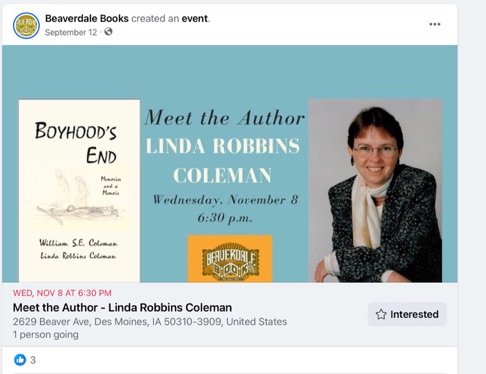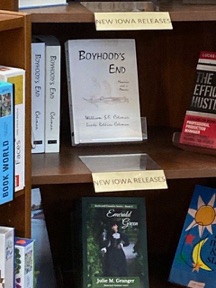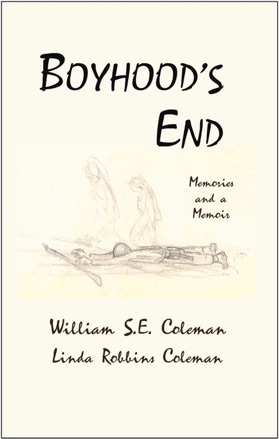Boyhood’s End Memories and a Memoir


Enjoy a discussion about Boyhood’s End on YouTube!
https://www.youtube.com/watch?v=r0-wnErnzBM

in Hardcover and Paperback
This book can be ordered from Amazon.com
BarnesandNoble.com, other online booksellers,
or through your local bookstore.
Hardcover ISBN: 979-8-9885470-1-3
Paperback ISBN: 979-8-9885470-0-6

Boyhood’s End is the remarkable true story of a young man finding his way through a changing culture and a world at war. From high school through his enlistment in the Army, from his experiences as a front-line combat infantryman in Patton’s Third Army during the Rhineland Campaign to his return home at end of World War II, this “memories and a memoir” provides readers with an intimate portrait of a personal journey through an epic time.
Boyhood’s End combines history, cultural memories, and social commentary punctuated with more than a hundred of Coleman’s images and illustrations from that time. It describes prevalent social attitudes and customs of the era, popular entertainers and cultural offerings, notable political and military figures, and significant historical events that impacted the lives of his generation and remain influential to this day.
While there has been a resurgence of interest in the Greatest Generation in recent years, the number of actual combat veterans who have shared their stories is relatively small. With Boyhood's End, William S.E. Coleman introduces a new voice to the canon of World War II accounts and adds a fresh perspective on an era that is quickly disappearing from our view. Personal memories are mixed with excerpts from the Infantry history that Coleman co-authored and co-illustrated at the end of the war. For his service, he was awarded the Combat Infantryman Badge and two Bronze Stars.
“Authors William S.E. Coleman and Linda Robbins Coleman have created a rich narrative that reads like a novel and is as informative as a documentary. A must-read for anyone interested in the World War II era.”

*******
When Pearl Harbor was attacked and war was declared in December 1941, the population of the United States of America was about 133 million. During the next four years, more than 16 million Americans served in World War II.
Approximately 800,000 (fewer than 5%) of all US military personnel experienced serious combat in World War II. The Infantry represented only 14% of troops overseas.
According to the US Department of Veterans Affairs, less than 150,000 of those 16 million are still alive at the time of Boyhood’s End publication in 2023. These men and women, all in their mid-90s or older, are dying at the rate of 180 per day. Only a handful will be alive in ten years.
While there has been a resurgence of interest in the Greatest Generation in recent years, the actual number of combat veterans who shared their stories of this remarkable time is relatively small.
With Boyhood's End, William S.E. Coleman introduces a new voice to the canon of World War II accounts. This “memories and a memoir” provides readers with a fresh perspective on an era that is quickly disappearing from our view. Personal memories are mixed with excerpts from the 417th Infantry history that Coleman co-authored and co-illustrated at the end of the war.
Boyhood’s End combines history, cultural memories, and societal commentary punctuated with Coleman's remarkable images and illustrations from that time. It vividly portrays the adventures and observations of a boy becoming a man, and details Coleman's experiences as a front-line combat infantryman in Patton's Third Army during the last two months of the Rhineland Campaign. One of the last age groups to see front-line combat in World War II, he was awarded the Combat Infantryman Badge and two Bronze Stars for his service.

*******
Boyhood’s End Synopsis
The first half of Boyhood’s End describes life in a Pennsylvania mill town during the Great Depression and pre-war years to the attack on Pearl Harbor on December 7, 1941, and our entrance into World War II. Readers get a glimpse into the joys and trials of being a typical American boy whose future will hinge on events overseas.
As the war effort ramps up, Coleman drops out of high school to enlist. The Army’s assignment to study engineering at Virginia Military Institute provides opportunities and challenges that will determine his future. After D-Day in June 1944, Coleman is transferred to Camp Wheeler, Georgia, where he survives basic training and prepares to ship out.
The second half of Boyhood’s End details Coleman’s experiences crossing the Atlantic and entering the European Theatre of Operations to become a member of the 417th Infantry Regiment in the 76th Division of General George S. Patton’s Third Army. He joins Charley Company, a rifle company on the front lines. The weaponry, supplies, and tactics the men in C Company will need to survive combat are described. The realities of war, both physical and emotional, are brought home as they work together to become a fighting unit. Personal memories are mixed with excerpts from Always First, the 417th Infantry history that Coleman co-authored and co-illustrated at the end of the war.
Marching across Germany, the soldiers encounter fierce opposition in fields and towns. Casualties occur alongside the victories. Shelled by German artillery and strafed by the Luftwaffe, these young men witness thousand-plane raids, deal with mass surrenders of German soldiers, and continue their advance through thousands of fleeing refugees and Displaced Persons. Fighting continues until May 7, 1945, when Germany surrenders. The war in Europe is over.
Occupation duty at the end of the war presents new dangers, opportunities, and perspectives along with a quick adventure in Paris before returning to the USA. Coleman is assigned to post-war duty in Kentucky until his discharge on July 1, 1946. For his service, he is awarded the Combat Infantryman Badge and two Bronze Stars. Boyhood’s End concludes with reflections on how this extraordinary time impacted and influenced the choices he made and the actions he took for the rest of his life.
******
Boyhood’s End Contents
Part One: “A Date Which Will Live in Infamy” describes life in a Pennsylvania mill town during the Great Depression and pre-war years leading up to the December 7, 1941, attack on Pearl Harbor and our entrance into World War II. Readers get a glimpse into the joys and challenges of being a typical American boy whose future will hinge on events overseas.
Part Two: “A Young Man Goes to War.” After dropping out of high school to enlist, Coleman adjusts to a completely different world when the Army sends him to the Virginia Military Institute to study engineering.
Part Three: “The Real Army.” Following the D-Day invasion, the Army transfers him to Camp Wheeler, Georgia where he survives basic training and prepares to ship out.
Part Four: “Into a Theatre of War” recounts crossing the Atlantic and entering the European Theatre of Operations where he becomes a member of the 417th Infantry Regiment in the 76th Division of General George S. Patton’s Third Army. He joins Charley Company, a rifle company on the front lines. Readers learn about the weaponry, tactics, and supplies the men in C Company will need to survive combat. The realities of war, both physical and emotional, are brought home as they work together to become a fighting unit. Personal memories are mixed with excerpts from Always First, the 417th Infantry history that Coleman co-authored and co-illustrated at the end of the war.
Part Five: “Into the Heart of Germany” describes crossing the Rhine and the long advance through Germany to defeat the Third Reich. The daily life of a combat infantryman on the front lines is vividly portrayed, from digging foxholes to fighting in the streets, from being shelled and strafed to dealing with the mass surrender of German soldiers. Casualties occur alongside the victories. Their advance continues through a sea of humanity as thousands of refugees and Displaced Persons flee to safety behind the front lines. Fighting continues until May 7, 1945, when Germany surrenders. The war in Europe is over.
Part Six: “Occupation Duty Begins” gives an account of the early days of keeping the peace, guarding a slave labor camp, capturing a circus, working as a cartoonist and writer for the Battalion history, sightseeing and adventures in Reims and Paris, and, finally, beginning the long voyage home.
Part Seven: “Odyssey’s End.” Back in the USA, Coleman finishes his Army duty as an occupational counselor in Kentucky until his discharge on July 1, 1946. For his service, he is awarded the Combat Infantryman Badge and two Bronze Stars.
Part Eight: “Reflections” is a look back and final thoughts on how World War II impacted and influenced the choices he made and actions he took for the rest of his life.
******
AUTHOR BIOGRAPHIES
William S.E. Coleman dropped out of high school and enlisted in the US Army in 1944 at the age of 17. One of the last age groups to see front-line combat in World War II, he was awarded the Combat Infantryman Badge and two Bronze Stars for his service. After the war he attended college through the G.I. Bill of Rights, and enjoyed an illustrious career as an award-winning playwright, screenwriter, historian, author, director, and professor of theatre arts.
Linda Robbins Coleman is an award-winning composer, pianist, writer, research associate, and arts ambassador whose music is regularly performed and broadcast throughout North America and Europe. She was the first Iowa woman to have music performed by a major symphony orchestra and to serve as Composer-in-Residence with any orchestra.
Boyhood’s End is the culmination of William and Linda’s forty-year-long personal and professional partnership. Over the years they collaborated on more than thirty theatre productions, dozens of scholarly articles, books, plays, and music. Their advocacy and contributions to non-profit arts organizations and individual artists have been celebrated here and abroad. Their Voices of Wounded Knee (published by University of Nebraska Press) was the first book to give equal weight to the testimony of Native Americans and is considered the definitive book on this topic.
